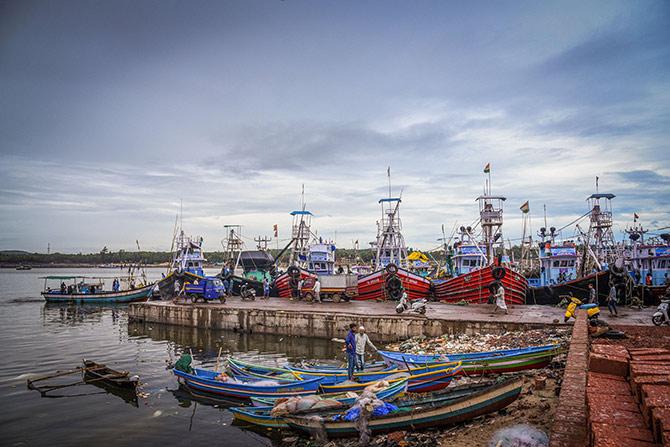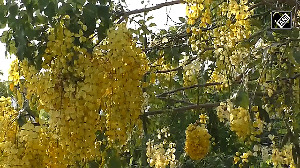'When there is a change in the wind speed or the stress exerted on the surface, it will change the ocean currents.'

"The changes in ocean temperature -- for example, Pacific and Indian Ocean temperatures -- can have a control over the monsoon through Indian Ocean Dipole and El Nino events. It can even change the rainfall patterns," Dr Jayanarayanan Kuttippurath, assistant professor at the Centre for Oceans, Rivers, Atmosphere and Land Sciences, IIT-Kharagpur, tells Shobha Warrier/Rediff.com in the concluding segment of a two-part interview:
Do you feel not only people, but policymakers are also not aware of how grave the situation is?
We have policies and laws to protect our environment. Perhaps, implementation is not that effective. Some are not aware of the consequences.
That is why awareness programmes are necessary to educate people.
At least those who are working in the field can tell the truth loudly; that is, climate change is a reality.
A report says that global warming is speeding up Earth's massive ocean currents. How does this happen?
The surface currents are driven by winds.
When there is a change in the wind speed or the stress exerted on the surface, it will change the ocean currents.
There are studies showing the changes in speed of the currents in different oceanic regions.
One example would be the change in the ventilation of southern ocean due to the effect of Antarctic ozone hole.
If the temperature and heat content of the ocean are changing, that will also affect the ocean circulation.
Studies have already shown that there is noticeable increase in oceanic temperature across the depths
The changes in ocean temperature -- for example, Pacific and Indian Ocean temperatures -- can have a control over the monsoon through Indian Ocean Dipole and El Nino events.
It can even change the rainfall patterns.
There was a time it was said that afforestation was the answer to fix climate change and there was a slogan of planting a billion trees. Now they say that afforestation alone cannot fix climate change.
Trees are indeed helpful but planting trees alone will not fix climate change.
What kind of trees we plant and where we plant is also important.
What is needed is to look at what changes the climate.
Changing Earth's surface in different ways like preserving the forests, water bodies and hills, and control greenhouse gas emissions are very important.
Protection of our environment is key to combat climate change./p>
Then, there are some changes that have already happened like some changes in the ocean. Now, how do we get it reversed?
Can we reverse such changes?
It may be possible, but it will take time.
You asked me about the change in the circulation of ocean due to climate change. This is something that has already happened.
Now, how do we make it back to normal?
For example, I work a lot on the Antarctic ozone hole. Studies show that this resulted in changes in the climate of the entire southern hemisphere.
We found this, 30 to 40 years after the first appearance of the ozone hole.
From the late 1970s, it took us 30 to 40 years to detect these changes. So, it would take that much time or even longer time period to get it reversed, that is, when the Antarctic ozone hole is gone and everything is back to normal.
It was reported that an ozone hole the size of Greenland over the Arctic pole has closed and healed. Does that give hope?
This is different. Ozone loss is a seasonal phenomenon.
This is for the first time that there was an ozone hole situation in the Arctic region. It is a matter of concern as an ozone hole in the Arctic means millions of people get exposed to dangerous ultra-violet radiation.
In the northern hemisphere, there are more countries and more people living there.
And the ozone hole or the polar vortex can move to different regions. It can move towards the Scandinavian countries or more populated areas in and around the Arctic Circle.
So, the Arctic ozone hole is more worrisome than the Antarctic ozone hole in this regard. In Antarctica, it may also move to the South American region.
The reports were wrong to state that the ozone hole healed itself. It is a meteorological phenomenon and it will appear in winter and vanish in late spring, by the end of March or April, anyway.
However, it has to be noted that, although ozone loss -- not ozone hole -- occurs at different scales every spring in the Arctic, the situation that the loss deepens to make an ozone hole is rare as in the case of Arctic ozone hole in 2020.
There was a similar situation in 2011. It would take 30 to 40 years or even longer to completely heal the Antarctic ozone hole and the Arctic ozone loss.
Some reports suggested that it has to do with the lockdown.
It is very unlikely. The polar ozone loss chemistry is very different. There is no direct relationship, as most of the ozone-depleting substances responsible for ozone loss are regulated and their concentrations in the atmosphere are decreasing.
Nevertheless, the wave activity was very weak this year, and that was the reason for the polar vortex to sustain even up to the last week of April.
Normally the vortex dissipates by mid-March in the Arctic and eventually the ozone loss terminates.
We have to examine whether there is any meteorological change due to this calm lockdown period that could affect the Arctic temperatures.
There is no published evidence yet to establish that this Arctic ozone hole is related to the lockdown.
As a scientist working the ozone hole in the Antarctic region, have you noticed any change in the region after the global lockdown?
There can be, but not directly.
Also, we need to wait until the Antarctic Spring (August to November 2020) to study or find any related change due to this lockdown.
As I said before, the ozone hole phenomenon is seasonal and its chemistry is very different.
However, some of the pollutants are greenhouse gases that can warm the atmosphere.
The impact depends on how much pollutants are there and how long they stay there.
Remember, the lockdown period was short. If there had been a longer lockdown period -- for a couple of years -- we may witness noticeable changes.
What we have observed is, pollution levels have come down significantly in these last three months, for sure.
We do not know how much long-term impact this will have on ozone hole.
Once the lockdown is over, life will be back to normal.
What kind of a planet are we giving to the future generations? Are we not being irresponsible?
The planet we are passing on to the future generations is not as good as the one we got from our ancestors.
Today, temperatures have risen, there is severe pollution, forest fires are happening, so also floods.
Many of these have negative health effects on human beings.
We are giving a bad environment to the future generations. But we are also trying to mend our ways.
As a climate scientist, are you happy with the way people are dealing with climate change?
Not really. There is not enough awareness, and many people do not know the gravity of the situation and far-reaching implications of climate change.
The responsibility lies not just with policymakers, but every individual has a role to play.
People have to change their attitude that it is not happening in my backyard.
It is like cleaning the drains just before the monsoon rains. It has to be, we should not be creating a situation where drains have to be cleaned before the monsoon.











 © 2025
© 2025